Is it machine learning or artificial intelligence? It ends up depending who you ask and what is it you care about.
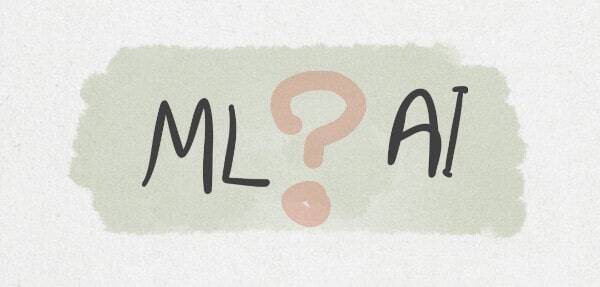
There are multiple ways to think and look at machine learning and artificial intelligence. And just like any other hyped technologies, people seem to mix the two and use them interchangeably.
I’ll let you in on a little secret: we’re doing the same with our upcoming AI in RTC report.
Want to help us with our research AND get a free ebook AND have a chance to win one of five $100 Amazon gift cards?
We could have just as easily use the title “ML in RTC” instead of “AI in RTC”. The way we’d approach and cover the space and end up writing this market research would be… the same – in both cases.
Why?
- I’ve never been a stickler to such details, especially when so many are mixing them up
- This is the same as having VoIP, Convergence, UC and now Teams mean the exact same things – just slightly differently
- Or why WebRTC is both a standard specification (almost at least) and an open source project implementing an approximation of that standard specification
- And it is why people mix between ML and AI. The distinctions aren’t big enough for most of the population to care – or understand
- Marketing
- Whenever a new technology or term becomes interesting and gets hyped, overzealous marketing and sales people would start using it and abusing it
- Which is what we see with this whole AI thing that is just everywhere now
- So why not us with our new report about AI in RTC?
Which brings me to this article.
Machine Learning and Artificial Intelligence are somewhat different from one another. The problem is to decide what that difference is.
Here are 4 ways to think about ML and AI:
#1 – ML = AI

Let’s start with the easiest one: ML is AI. There’s no difference between the two and they can be used interchangeably.
This is the viewpoint of the marketer, and today, of the market itself.
When everyone talks about AI, you can’t not talk about AI. Even if what you do is just ML. Or BigData. Or analytics. Or… whatever. Just say you’re doing AI. It is good for the health of your stock price.
While at it, make sure to say you’re doing AI in an ICO cryptocurrency fashion. What can go wrong?
Someone tells you he is doing AI? Assume ML, and ask for more information. Make your own judgement.
#2 – The road to AI
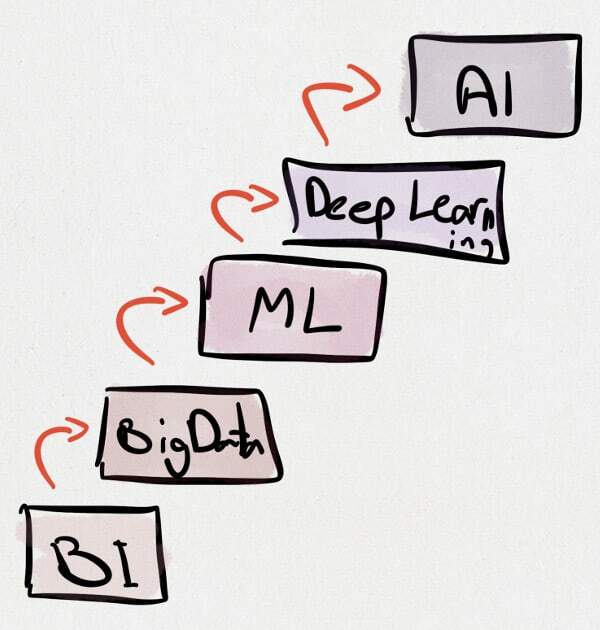
From Operational to BI
We’ve had databases in our products for many years now. We use them to store data, run transactions and take actions. These are known as operational databases. For many years we’ve had another set of databases – the analytical ones, used in data warehouses. The reason we needed them is because they worked better when asking questions requiring aggregations that look at large series of historical data.
That got the marketing terms of BI (Business Intelligence) and even Analytics.
BI because we’re selling now to the business (at a higher price point of course). And what we’re selling is value.
Analytics because it sounds harder than the operational stuff.
From BI to BigData
The next leg of that journey started about a decade ago with BigData.
Storage started costing close to nothing, so it made sense to store everything. But now data warehouses from the good-ol’ BI days got too expensive and limiting. So we came out with BigData. Things like Hadoop and Cassandra came to be and we were happy again.
Now we could just throw all our data into Hadoop and run batch processes on it called MapReduce that ended up replacing/augmenting our data warehouses.
BigData was in big hype for some time. While it is very much alive today, it seems to have run out of steam for marketers. They moved on to Machine Learning.
From BigData to ML
This step is a bit more nuanced, and maybe it isn’t a step at all.
Machine Learning covers the research area of getting machines to decide on their own algorithm – or more accurately – decide on how an algorithm will be used based on a given dataset.
Machine learning algorithms have been around well before machines. If you check the notes on Wikipedia for Linear Regression, you’ll find the earliest methods for it were published in 1805. And to be fair, these algorithms are used in BI as well.
The leap from BigData to ML happened mostly because of Deep Learning. Which I am keeping as a separate leap from ML. Why? Because many of the things we do today end up being simpler ML algorithms. We just call it AI (or ML) just because.
Deep Learning got everyone on the ML bandwagon.
From ML to Deep Learning
Deep Learning is a branch of Machine Learning. A certain type of machine learning algorithms.
They became widely popular in recent years since they enabled the accuracy of certain tasks to increase significantly.
There are two things we can now achieve due to deep learning:
- Better image classification
- Better accuracy in speech to text
Here’s how Google fairs now (taken from KPCB internet trends):
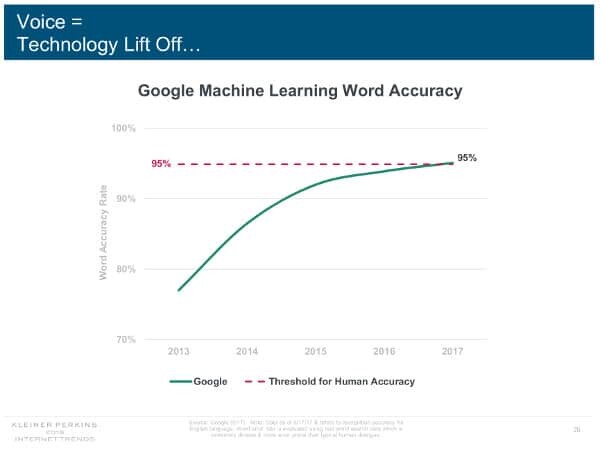
We’ve been around the 70% accuracy at 2010, after a gradual rise in the past 40 years or so from 50%.
This steep rise in accuracy in this decade is attributed to the wide use of machine learning and the amount of data available as training material to the algorithms.
Deep learning is usually explained as neural networks, making it akin to human thinking (at least until the next wave of better algorithms will be invented which are more akin to human thinking).
From Deep Learning to AI
And then there’s artificial intelligence.
Less a specific algorithm and more a target. To replace humans. Or to do what humans can do.
Or my favorite:
AI is a definition of what we can’t do with machines today.
Once we figure that out, we’ll just put AI on the next pedestal so we’ll have a target to conquer.
#3 – Learning or Imitating?
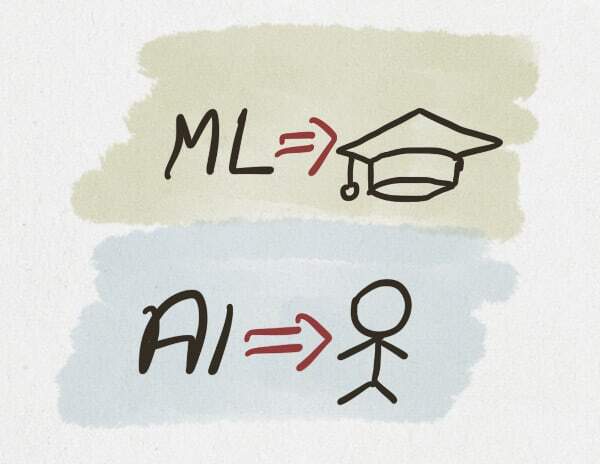
Here’s one that is slightly different. I heard it at a data science event a couple of weeks ago.
Machine Learning is about getting machines to select their own algorithm by presenting them a set of rules and outcomes:
- You give a machine voice recordings, along with the transcription. And let them decide from that input on a new voice recording what the transcription should be
- You give a machine the rules to play a game, and let it play many times (millions?) until he gets better at it, devising his own algorithm and strategy
Artificial Intelligence is about doing something a human can do. Probably with the intent to replace him by automating the specific task. Think about autonomous driving – we’re not changing the roads or the rules of driving, we just want a car to drive itself the way a human would (we actually want the machine to drive better than humans).
So:
- Machine Learning is about letting a machine devise his own algorithm based on data we give it
- Artificial Intelligence is about doing a task the way a human would
#4 – Predictions vs Actions
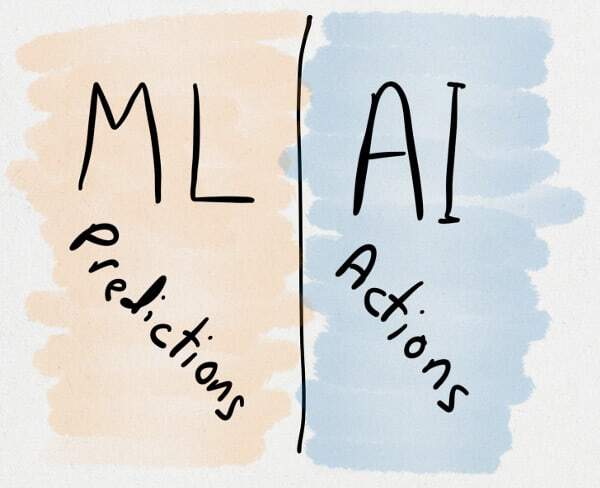
This one I saw at a recent event, which got me on this track of ML vs AI in the first place.
Machine Learning is about Predictions, while Artificial Intelligence is about Actions.
You can use machine learning to understand things, to classify them, predict and estimate. But once the time comes to act upon it, we’re in the realm of artificial intelligence.
It also indicates that any AI system needs ML to operate.
I am sure you can poke holes in this one, but it is useful in many ways.
Why do we care?
While I am not a stickler to such details, words do have meaning. It becomes an issue where everyone everywhere is doing AI but some end up with a Google Duplex while others show a rolling average on a single metric value.
If you are using communications and jumpstarting an AI initiative, then be sure to check out our upcoming report: AI in RTC.
Want to help us with our research AND get a free ebook AND have a chance to win one of five $100 Amazon gift cards?

Having commented here for too long, but here goes…
You say that AI=ML but then you show the road from ML to AI (which I agree with). Strange.
In general I would say that AI (Artificial Intelligence) is a concept of machines being able to contain intelligence, “smarts”, and carry out tasks according to it (something today only humans can do).
ML (Machine Learning) is based around an idea that you can provide a machine (algorithm) data and it will adapt itself (its algorithm) accordingly without human intervention. This is the current state of AI today, an specific application of it.
In that sense, ML can also take actions, not just make predictions. But it’s always based on past data that’s being provided. And future AI might not necessarily have ML inside, just like us humans don’t.
Sagee,
If the only thing I got out of this article is you commenting here then it is already worth it 🙂
I do tend to agree with you on the first part – ML is providing an algorithm a machine can adapt itself with; AI is about carrying out tasks – which fits into predictions vs actions model 🙂
I like to think of AI as “what we can’t do today”, which means we will never have AI… until the robots kill us all
I think i agree with Sagee,
AI in it’s broader meaning, can definitely be a computer doing stuff based on algorithms which aren’t based on “learning”.
for example, the deep blue chess computer was running algorithms that were completely written by humans without learning anything or getting better by itself.
Here’s the interesting part then – would you define it today as AI or just an expert system with brute force capabilities?
we had quite a conversation about this article here at the office.
i guess it depends on what goes in “broader meaning” of AI… 🙂
Computer Science has answered that question long time ago:) Artificial intelligence (father) is a subfield of computer science and machine learning (baby) is a part of it.
Val,
This still doesn’t really answer what falls into the field of AI (and what doesn’t), and which parts of AI are ML.
Your blog is really good, It is really helpful and I would like to share your information. If anyone wants to learn AI at an advanced level. Chooch is an AI-Based Company that provides you training for AI Startup, visual search, image recognition solutions, and AIoT. Free AI Demos From our Experts.